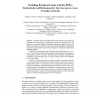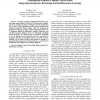1954 search results - page 35 / 391 » Modelling Coordination in Biological Systems |
CMSB
2009
Springer
15 years 4 months ago
2009
Springer
Circadian clocks are biochemical networks, present in nearly all living organisms, whose function is to regulate the expression of specific mRNAs and proteins to synchronise rhyth...
IAT
2010
IEEE
14 years 7 months ago
2010
IEEE
Abstract--The paper proposes a biologically-inspired cognitive agent model, known as FALCON-X, based on an integration of the Adaptive Control of Thought (ACT-R) architecture and a...
FUIN
2006
14 years 9 months ago
2006
In this paper we present a coordination model for component-based software systems based on the notion of mobile channels, define it in terms of a compositional trace-based semanti...
113
click to vote
BMCBI
2008
14 years 9 months ago
2008
Background: In systems biology, and many other areas of research, there is a need for the interoperability of tools and data sources that were not originally designed to be integr...
ECCC
2000
14 years 9 months ago
2000
Experimental data show that biological synapses behave quite differently from the symbolic synapses in all common artificialneuralnetwork models. Biological synapses are dynamic, ...


